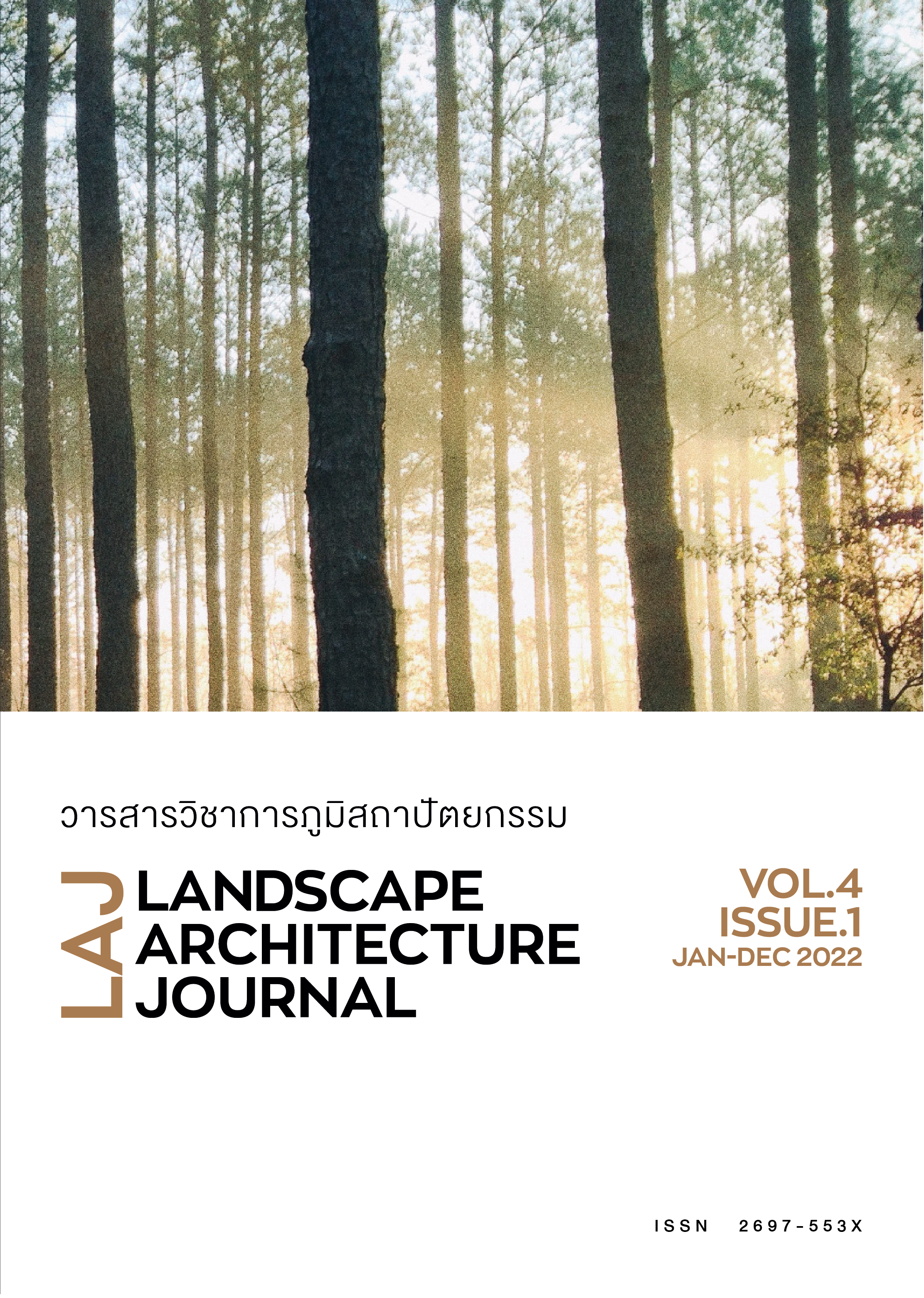Brownfield Redevelopment in Thailand
Main Article Content
Abstract
Brownfield is one of the environmental development processes in urban area. In order to reuse the land, the redevelopment is required to clean up the presence hazardous substance or contamination where the success of redevelopment is derived from policy and tools. The objective of this article is to study the brownfield redevelopment process in Thailand through the regional brownfield redevelopment projects by referring to the concept, definition, classification, procedure, and redevelopment process. This article exemplifies five study cases of brownfield redevelopment projects in Thailand that have been successfully developed, which are Kaomai Estate 1955, Nhapha Khao Yai Resort, Princess Galyani Vadhana Institute of Music and Rama VIII Park, Ramintra Sport Park and Benchakitti Park. The study demonstrates that the Brownfield projects in Thailand mostly located in the city, with high potential in redevelopment led by government. Also, most of the redevelopment projects were the abandoned factories with low-risk hazard degree and showed least evidence in contamination. As a result, redevelopment process is less complex and able to utilize the existing historical building. It is essential to set up the policy and the process in Brownfield redevelopment in Thailand to stimulate the successful and sustainable development.
Article Details

This work is licensed under a Creative Commons Attribution-NonCommercial-NoDerivatives 4.0 International License.
References
กรมควบคุมมลพิษ. (2555). แผนการจัดการมลพิษ พ.ศ. 2555-2559. กรุงเทพฯ: กรมควบคุมมลพิษ.
กองจัดการกากของเสียและสารอันตราย กรบควบคุมมลพิษ. (2564). (ร่าง) แนวทางการประเมินพื้นที่ปนเปื้อนมลพิษเบื้องต้น (Preliminary Assessment). สืบค้นจาก https://www.pcd.go.th/wp-content/uploads/2021/06/pcdnew-2021-06-30_06-05-12_019070.pdf
การยาสูบแห่งประเทศไทย. (2558). ประวัติการยาสูบแห่งประเทศไทย. สืบค้นจาก https://www.thaitobacco.or.th/th/ about-us
การยาสูบแห่งประเทศไทย. (2562). ความเป็นมาและเหตุผลความจำเป็นในการย้ายโรงงานยาสูบ. สืบค้นจาก http://ttminfo.thaitobacco.or.th/info/wp-content/uploads/2015/09/ความเป็นมาและเหตุผลความจำเป็นในการย้ายโรงงาน.pdf
กิตติ์สิริ แก้วพิพัฒน์. (2551). แนวคิดการจัดการของเสียอุตสาหกรรมในต่างประเทศกับทิศทางการพัฒนาการบริหารจัดการในประเทศไทย. ใน สำนักงานกองทุนสนับสนุนการวิจัย, เวทีสาธารณะครั้งที่ 1 : เรียนรู้การจัดการของเสียในต่างประเทศเพื่อพัฒนาทิศทางการจัดการของไทย (น. 8-12). กรุงเทพฯ: สำนักงานกองทุนสนับสนุนการวิจัย.
ไข่มุก แสงมีอานุภาพ. (2561). Kaomai Estate 1955: การเปลี่ยนผ่านจากโรงงานยาสู่โรงแรมและคาเฟ่ในโครงการ Kaomai Estate 1955 พื้นที่ที่บอกเล่าประวัติศาสตร์ได้อย่างรื่นรมย์. สืบค้นจาก https://readthecloud.co/kaomai-estate-1955
จิรณรงค์ วงษ์สุนทร. (ม.ป.ป.). วิ่งขึ้นเนินที่สวนกีฬารามอินทรา. สืบค้นจาก https://adaymagazine.com/run-20
จิรัฏฐ์ ประเสริฐทรัพย์. (2562). Kaomai Estate 1955 คาเฟ่แห่งแรกในไทยที่ได้รับรางวัลดีเด่นด้านการอนุรักษ์จากยูเนสโก. สืบค้นจาก https://themomentum.co/kaomai-estate-1955-winning-projects-of-unesco
โชติกา โภคาธิกรณ์. (2564). "สวนป่าเบญจกิติ" สวนป่าใจกลางเมืองกว่า 300 ไร่. สืบค้นจาก https://thelist.group/realist/ blog/สวนป่าเบญจกิติ-เฟสใหม่
ถาวร โกอุดมวิทย์. (ช่างภาพ). (2555). การปรับสภาพพื้นที่โครงการหน้าผาเขาใหญ่รีสอร์ท. [ภาพดิจิทัล]. ไทย: ช่างภาพ.
ธมนวรรณ กัวหา. (23 เมษายน 2562). มองบรรยากาศแสนรื่นรมย์ที่สะพานพระราม 8. สืบค้นจาก https://adaybulletin.com/life-viewfinder-rama-viii-bridge/30745
บ้านและสวน. (26 กันยายน 2559). หน้าผา เขาใหญ่ รีสอร์ท. สืบค้นจาก https://www.baanlaesuan.com/26067/ design/lifestyle/cliff-khoyai-resort
เปิดภาพล่าสุด สวนป่าเบญจกิติ ปอดใหญ่กลางกรุง คาดเปิดใช้ก.พ.’65. (22 กันยายน 2564). มติชนออนไลน์. สืบค้นจาก https://www.matichon.co.th/social/news_2952802
พฤภัทร ทรงเที่ยง. (2562). ชมโครงการเก๊าไม้ เอสเตท 1955 เชียงใหม่ ที่ได้รางวัล UNESCO Heritage Awards 2018. สืบค้นจาก https://thestandard.co/kaomai-estate-1955
สถาบันดนตรีกัลยาณิวัฒนา. (2562). ประวัติความเป็นมา. สืบค้นจาก http://www.pgvim.ac.th/th/about.
สฤษดิ์ ติยะวงศ์สุวรรณ. (2555). การพัฒนาที่ดินบราวน์ฟิลด์. วารสารวิชาการคณะสถาปัตยกรรมศาสตร์ สจล, 14(2), 137-140.
สำนักงานสิ่งแวดล้อมและควบคุมมลพิษที่ 13 (ชลบุรี). (2562). กฎหมายสิ่งแวดล้อมน่ารู้. สืบค้นจาก http://reo13.mnre.go. th/th/news/detail/48832
สำนักวัฒนธรรม กีฬา และการท่องเที่ยว. (2550). ศูนย์กีฬาฯ รามอินทรา. สืบค้นจากhttp://www.bangkokgis.com/ project/culture/imagemap/sc_gis/sc_ramintra.html
สิฐินันท์ พรหมมณี. (2559). มาตรการทางกฎหมายเกี่ยวกับการหาผู้รับผิดชอบค่าใช้จ่ายในการบำบัดฟื้นฟูพื้นที่เหมืองทิ้งร่างที่ปนเปื้อนสารอันตรายของประเทศสหรัฐอเมริกาและประเทศไทย. (วิทยานิพนธ์ปริญญามหาบัณฑิต). มหาวิทยาลัยสงขลานครินทร์, สงขลา.
สุธาวัลย์ เสถียรไทย, ดิเรก ปัทมสิริวัฒน์, โสภารัตน์ จารุสมบัติ, วรเวศม์ สุวรรณระดา, พิชญ รัชฎาวงศ์, โสภณ ตะติโชติพันธุ์, และ วิพล กิติตทัศนาสรชัย. (2550). ข้อเสนอทางเลือกของมาตรการการป้องกันและฟื้นฟูความเสียหายจากการปนเปื้อนดินและน้ำใต้ดิน. กรุงเทพฯ: สถาบันธรรมรัฐเพื่อการพัฒนาสังคมและสิ่งแวดล้อม.
เส้นทางสุขภาพ. (2552). สวนกีฬาฯ รามอินทรา. สืบค้นจาก http://www.yourhealthyguide.com/parks/park-ramindra.htm
อำนาจ วงศ์บัณฑิต. (2550). กฎหมายสิ่งแวดล้อม (พิมพ์ครั้งที่ 2). กรุงเทพฯ: สำนักพิมพ์วิญญูชน.
Workpoint Today. (2562). “เก๊าไม้ เอสเตท 1955” คาเฟ่แห่งแรกในไทยที่ได้รางวัลอนุรักษ์มรดกทางวัฒนธรรมจากยูเนสโก. สืบค้นจาก https://workpointtoday.com/เก๊าไม้-เอสเตท-1955-คาเฟ่แ
Bardos, P. (2003). The Contaminated Land Rehabilitation Network for Environmental Technologies in Europe - Final Report for Research Contract CLL 35/1/12: Managing and Developing the UK Interface with CLARINET. London: Department for Environment Food and Rural Affairs.
Bardos, P. (2006). CABERNET Concerted Action on Brownfield and Economic Regeneration Network. Retrieved from http://www.eugris.info/displayproject.asp?Projectid=4415
Chun-Yang, S. Y., & Talib, M. (2006). Overview of brownfields in Malaysia. Engineer Bulletin, April, 16-23.
Collaton, E., & Bartsch, C. (1996). Industrial Site Reuse and Urban Redevelopment - An Overview. Cityscape: A Journal of Policy Development and Research, 2(3), 17-61.
CORDIS. (1996). CARACAS - Concerted action on risk assessment for contaminated sites in the EU. Retrieved from https://www.ecologic.eu/797
CORDIS. (2001). Regeneration of European sites in cities and urban environments. Retrieved from https://cordis.europa.eu/project/id/EVK4-CT-2001-00068/it
Ecologic Institute. (2009). Common Forum on Contaminated Land. Retrieved from https://www.ecologic.eu/ 797
Erdem, M., & Nassauer. J. I. (2013). Design of Brownfield Landscapes Under Different Contaminant Remediation Policies in Europe and the United States. Landscape Journal: design, planning, and management of the land, 32(2), 277-292.
Ferber, U., & Grimski, D. (2002). Brownfields and Redevelopment of Urban Areas. Vienna: Umweltbundesamt GmbH.
Ferber, U., Grimski, D., Millar, K., & Nathanail, P. (2006). Sustainable Brownfield Regeneration: CABERNET Network Report. Nottingham: CABERNET Coordination.
Ferber, U., Nathanail, P., Jackson, J. B., Gorski, M., Drobiec, L., & Petríková, D. (2006). Brownfields Handbook. New York, NY: Leonardo da Vinci Project Inc.
Guglielmi, A. O. (2005). Recreating the Western City in a Post-Industrialized World: European Brownfield Policy and an American Comparison. Buffalo Law Review, 25(4), 1273–1312.
Hollander, J. B., Kirkwood, N. G., & Gold, J. L. (2010). Principles of Brownfield Regeneration: Cleanup, Design, and Reuse of Derelict Land. Washington, DC: Island Press.
Jabatan Perancangan Bandar Dan Desa Semenanjung Malaysia (JPBD) (2012). Garis Panduan Perancangan: Pengenalpastian Bagi Pembangunan Semula Kawasan Brownfield. Kuala Lumpur: Jabatan Perancangan Bandar dan Desa Semenanjung Malaysia.
Kaomai Lanna Resort. (2017). Kaomai Estate 1955. Retrieved from https://www.kaomailanna.com/estate. php
Kurrer, C. (2021). Environment policy: general principles and basic framework. Retrieved from https://www.europarl.europa.eu/factsheets/en/sheet/71/environment-policy-general-principles-and-basic-framework
Ling, G. H. T., & Chyi Pung, J. (2019). An urban governance approach in the development of commercial brownfield: A case study of Iskandar Malaysia. International Journal of Built Environment and Sustainability, 6(1), 31–38.
Looi, P., & Majid, S. (2012). The First Step: Examine the Contaminated Land Management and Control Guidelines. Retrieved from https://www.skrine.com/insights/newsletter/september-2012/the-first-step
Rafson, H. J., & Rafson, R. N. (1999). Brownfileds: Redeveloping Environmentally Distressed Properties. New York, NY: McGraw-Hill Professional.
United Stages Environmental Protection Agency. (2019). Anatomy of Brownfields Redevelopment. Retrieved from https://www.epa.gov/brownfields/anatomy-brownfields-redevelopment-0
Yakhlef, M., & Abed, A. (2019) Identification of brownfield sites, classification and typologies case study of Amman, Jordan. Journal of Engineering and Applied Sciences, 14(10), 3144 - 3149.

